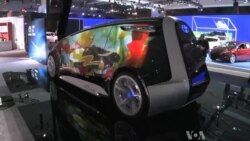WASHINGTON —
At this week's annual Washington Auto Show, manufacturers are featuring their standard models along with cars that point to the future, both in terms of propulsion and multi-material body structures.
Besides old concepts, repackaged in newly designed bodies, many manufacturers are showing models that are test beds for new technologies that point to the industry's future.
One model attracting a lot of attention is Toyota’s hydrogen-powered FCV Concept, which may be offered to consumers as soon as next year.
Its fuel cell converts hydrogen’s energy to electricity that charges the car’s battery. Hydrogen is abundant and cheap, and the only byproduct of its use is clean water.
The head of Vehicle System Design at South Carolina’s Clemson University, Zoran Filipi, says that fuel cells are the long-term environmental solution.
“Recent announcements about this technology becoming available to consumers are great because it’s going to allow for real-world experience, evaluation of this technology, and will prepare us for the future where, at some point, the infrastructure might become available too,” he said.
Toyota claims the car has a range of at least 500 kilometers and that filling the tank takes no longer than refueling a gasoline vehicle tank.
But cars with regular engines, still the most affordable for ordinary consumers, are also becoming more environmentally friendly, especially diesel engines, which are again making their way into the luxury department.
Clemson University professor Zoran Filipi says internal combustion engines, IC for short, are fighting back.
"What we see is that the near term combination of these very advanced IC engine concepts - downsizing, turbocharging, direct injection and 7, 8, 9, 10-speed advanced transmissions, does allow 10, 15 even 20 percent improvement of fuel economy,” he said.
Hybrid engines are also making their way into the luxury car market. U.S. manufacturer Cadillac won this year’s prize for Green Car Technology for its ELR model, with an electric motor for driving and a small turbocharged gas engine for recharging the battery, thus extending its range.
The other new technology on the rise is recycled and composite materials for the car chassis - like BMW’s i3 - whose passenger compartment is completely made of carbon fiber-reinforced plastics, making it much lighter.
Filipi says lightweight materials and structures are absolutely critical for vehicles with heavy batteries.
“We might actually see a future with multi-material body structures - steel, aluminum, carbon fiber - all being used for the same vehicle, and a lot of welding replaced by gluing,” he said.
Filipi says that there is also active research on bio-based and biodegradable composites for automotive interiors that can take us to a sustainable future.
Judging by the models exhibited at this year’s Washington Auto Show, cars of the future will be increasingly cheaper to drive while their environmental impact will continue to drop.
Besides old concepts, repackaged in newly designed bodies, many manufacturers are showing models that are test beds for new technologies that point to the industry's future.
One model attracting a lot of attention is Toyota’s hydrogen-powered FCV Concept, which may be offered to consumers as soon as next year.
Its fuel cell converts hydrogen’s energy to electricity that charges the car’s battery. Hydrogen is abundant and cheap, and the only byproduct of its use is clean water.
The head of Vehicle System Design at South Carolina’s Clemson University, Zoran Filipi, says that fuel cells are the long-term environmental solution.
“Recent announcements about this technology becoming available to consumers are great because it’s going to allow for real-world experience, evaluation of this technology, and will prepare us for the future where, at some point, the infrastructure might become available too,” he said.
Toyota claims the car has a range of at least 500 kilometers and that filling the tank takes no longer than refueling a gasoline vehicle tank.
But cars with regular engines, still the most affordable for ordinary consumers, are also becoming more environmentally friendly, especially diesel engines, which are again making their way into the luxury department.
Clemson University professor Zoran Filipi says internal combustion engines, IC for short, are fighting back.
"What we see is that the near term combination of these very advanced IC engine concepts - downsizing, turbocharging, direct injection and 7, 8, 9, 10-speed advanced transmissions, does allow 10, 15 even 20 percent improvement of fuel economy,” he said.
Hybrid engines are also making their way into the luxury car market. U.S. manufacturer Cadillac won this year’s prize for Green Car Technology for its ELR model, with an electric motor for driving and a small turbocharged gas engine for recharging the battery, thus extending its range.
The other new technology on the rise is recycled and composite materials for the car chassis - like BMW’s i3 - whose passenger compartment is completely made of carbon fiber-reinforced plastics, making it much lighter.
Filipi says lightweight materials and structures are absolutely critical for vehicles with heavy batteries.
“We might actually see a future with multi-material body structures - steel, aluminum, carbon fiber - all being used for the same vehicle, and a lot of welding replaced by gluing,” he said.
Filipi says that there is also active research on bio-based and biodegradable composites for automotive interiors that can take us to a sustainable future.
Judging by the models exhibited at this year’s Washington Auto Show, cars of the future will be increasingly cheaper to drive while their environmental impact will continue to drop.












